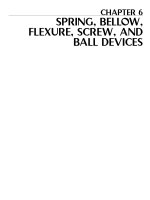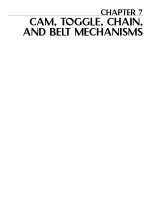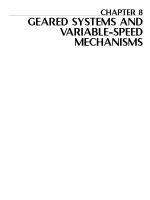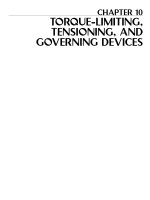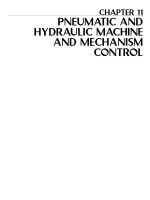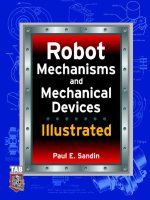McGraw-Hill - Robot Mechanisms and Mechanical Devices Illustrated - 2003 Part 14 ppsx
Bạn đang xem bản rút gọn của tài liệu. Xem và tải ngay bản đầy đủ của tài liệu tại đây (185.27 KB, 12 trang )
Chapter 11 Proprioceptive and Environmental Sensing Mechanisms and Devices 289
CONCLUSION
The information you’ve just read in this book is intended for those inter-
ested in the mehanical aspects of mobile robots. There are, of course,
many details and varieties of the mobile layouts, manipulators, and sen-
sors that are not covered—there are simply too many. It is my sincere
hope that the information that is presented will provide a starting point
from which to design your unique mobile robot.
Mobile robots are fascinating, intriguing, and challenging. They are
also complicated. Starting as simply as possible, with a few actuators,
sensors, and moving parts will go a long way towards the successful
completion of your very own mobile robot that does real work.
This page intentionally left blank.
A
Aaroflex, Inc., xviii
absolute encoders, 46f
accelerometers, 132
Ackerman, Rudolph, 190
Ackerman steering layout, xii, 152, 179f, 190
actuators
cable-driven joints, 203, 205
count, 67–68, 192
direct-drive rotary actuators in leg movement, 203, 205, 206f
linear actuators in leg movement, 202–203, 205f
and mobility system complexity, 235
motor linear, 41–43
in rocker bogie suspension systems, 154–155
rotary, 66f–68
and steering, 192–194
stepper-motor based linear, 42f–43
addendum circle, 87
AeroMet Corporation, xxviii
air-bearing stages, 13
all-terrain cycles (ATCs), 137, 197
Alvis Stalwart, 152
amplifiers. See motor drivers
analog-to-digital converters (ADCs), 60
Andros (Remotec), 155
Angle, Colin, xiii
angular displacement transducers (ATDs), 55–57, 56f
arm geometries, 245–249
articulated steering, 167
Asea Brown Boveri (ABB), 260
automatic guided vehicles (AGVs), 192–193
autonomous, term defined, xiii
autonomous manipulators, 241
axis stages, in motion control systems, 3
B
backlash, 88
Ballistic Particle Manufacturing (BPM), xvi, xxvii–xxix,
xxviii(f)
ballscrew drive, 12f
ballscrew slide mechanism, 6–7f
Bayside Controls, Inc., 104
bellows couplings, 14f–15
belts
about, 72–73
flat belts, 73, 74f
O-ring belts, 73, 74f
timing belts, 75f–76f
V-belts, 73–74f, 76–77
Bendix-Weiss joints, 116
bevel gears, 89, 102, 103f
Bradley Fighting Vehicle (U.S. Army), 167
bumper geometries
about, 280–282
3D motion detection, 287–288f
horizontal loose footed leaf spring, 285–286f
simple bumper suspension devices, 282, 283f
sliding front pivot, 286–287f
tension spring layout, 284f
three link planar, 283f–284
torsion swing arm, 284–285f
button switch, 266, 267f
Bv206 four-tracked vehicle (Hagglund), 166, 184
C
cable-driven joints, 203, 205
291
Index
Note: Figures and tables are indicated by an italic f and t, respectively.
Copyright © 2003 by The McGraw-Hill Companies, Inc. Click here for Terms of Use.
292 Index
CAM-LEM, Inc., xxiii
camming, electronic, 11
Carnegie Mellon University, xxx
cartesian arm geometry, 246f–247
center of gravity (cg) shifting, 131–134, 132f, 133f
cg. See center of gravity (cg) shifting
chain drives
ladder, 80f
rack and pinion, 82f
roller, 80–82f, 81f
silent (timing), 82–83f
chasms. See crevasse negotiation
chassis elevation, 132, 134f
Cincinnati Milacron, 260
circular interpolation, 10
circular pitch, 87
clearance, 87
closed-loop motion control systems (servosystems), 5–9, 5f,
6f, 7f, 8f, 18
cluster gears, 86f
commutation, 26–28f, 27f, 30, 34–35
computer-aided design (CAD), xiv, xvi
computer-aided motion control emulation, 10–11
cone clutches, 122f
cone drives, 84f
constant-velocity couplings, 115f–116f
contact ratio, 87
contouring, 10
controlled differential drives, 93–95f, 94f
control structures, xiii
costs
and actuator count, 68
and gearhead installation, 104–105
couplers
bellows couplings, 14f–15
Bendix-Weiss joints, 116
constant-velocity couplings, 115f–116f
cylindrical splines, 116f–119f, 117f, 118f
face splines, 120f
flexible shaft couplings, 14f
helical couplings, 14f–15
Hooke’s joints, 114f
of parallel shafts, 115f
Crawler Transporter (NASA), 165
crevasse negotiation, 163–164, 166, 234
Cubital America Inc., xx
cylindrical arm geometry, 247f
cylindrical splines, 116f–119f, 117f, 118f
D
dark fringe, 58
DCDT. See linear variable differential transformers
(LVDTs)
dead-reckoning error, 196
debugging, and actuator count, 67–68
dedendum circle, 87
degrees-of-freedom (DOF)
in manipulator arm geometry, 241–242, 245
degrees-of-freedom (DOF)
in manipulator wrist geometry, 250–251f
in walker mobility systems, 203–208, 204f, 205f, 206f,
207f
depth, in gears, 87
derivative control feedback, 9
design tools, xiv
diametrical pitch (P), 87
differential, 139–140f
Directed-Light Fabrication (DLF), xvi, xxix(f)–xxx
Direct-Metal Fusing, xxix
direct power transfer devices
couplers
Bendix-Weiss joints, 116
direct power transfer devices
couplers, 14f–15, 109–113f, 110f, 111f, 112f
bellows couplings, 14f–15
constant-velocity couplings, 115f–116f
cylindrical splines, 116f–119f, 117f, 118f
face splines, 120f
flexible shaft couplings, 14f
helical couplings, 14f–15
Hooke’s joints, 114f
of parallel shafts, 115f
torque limiters, 121–125f, 122f, 123f, 124f
Direct-Shell Production Casting (DSPC), xvi, xxvi(f)–xxvii
drive/steer modules, 195f–197f
drop on demand inkjet plotting, xx, xxviii(f)
DTM Corporation, xxi
dynamic stability, 201–202
E
E-chains, 243f
electric motors. See also direct power transfer devices;
indirect power tranfer devices
drive/steer modules, 195f–197f
linear servomotors, 17–18, 31–37, 32f, 33f, 34f
in motion control systems, 3, 4–5, 20–21, 71
permanent-magnet (PM) DC servomotors, 16–17, 18t,
21–31, 22f, 23f
brushless, 26–31, 27f, 28f
brush-type, 22–23, 26f
cup- or shell-type, 24–25f
disk-type, 23–24f
Index 293
(electric motors cont.)
stepper motors, 16, 18t, 37–40, 71
hybrid stepper motors, 38–40f, 39f
permanent-magnet (PM) stepper motors, 38
variable reluctance (VR) stepper motors, 38
electronic camming, 11
electronic commutation, 26–28f, 27f, 30
electronic gearing, 11
encoders
absolute encoders, 46f
incremental encoders, 44f–45f
linear encoders, 47f–48
magnetic encoders, 48f–49
rotary encoders, 6, 7f, 13, 19, 43–44
end-effectors. See grippers (end-effectors)
environmental sensing switches, 265, 266. See also limit
switches, mechanical
EOS GmbH, xxi
epoxy-core linear motors, 33–34f
external gears, 88
external pipe vehicles, 226
F
face gears, 90
face splines, 120f
Fanuc Robotics North America, 260
feedback sensors. See also limit switches, mechanical
accelerometers, 132
encoders, 43–49
inclinometers, 132
Inductosyns, 57
linear velocity transducers (LVTs), 55
in motion control system, 3, 43
position feedback, 19–20
selection basis, 20
tachometers
permanent magnet (PM), 52–53
shunt wound, 52
feedback sensors
angular displacement transducers (ATDs), 55–57, 56f
in closed loop systems, 5f–7f, 6f
encoders
absolute encoders, 46f
incremental encoders, 44f–45f
linear encoders, 47f–48
magnetic encoders, 48f–49
rotary encoders, 6, 7f, 13, 19, 43–44
laser interferometers, 7f, 13, 20, 57–59, 58f
linear variable differential transformers (LVDTs), 20,
53f–55, 54f
position sensors on ballscrew slide mechanisms, 7f
(feedback sensors cont.)
precision multiturn potentiometers, 59f–60
resolvers, 20, 30f, 49f–51
tachometers, 5, 20, 51f–53, 52f
flat belts, 73, 74f
flexible belt torque limiters, 122f
flexible face-gear reducers, 100–101f
flexible shaft couplings, 14f
foot size, walker, 210f
frame walking, 211f–213f, 212f
friction clutch torque limiters, 124f
friction disk torque limiters, 124f
friction drives, 83–84f
Fused-Deposition Modeling (FDM), xvi, xxiii–xxv, xxiv(f)
G
gait types, walker, 201–202
gantry manipulators, 246f
geared offset wheel hubs, 134f
gear efficiency, 88
gear power, 88
gear ratio, 88
gears, 85–105
bevel gears, 102, 103f
cluster gears, 86f
flexible face-gear reducers, 100–101f
gear classifications, 88–90
gear dynamics terminology, 88
gear terminology, 87–88
gear tooth terminology, 86f
harmonic-drive speed reducers, 96–100, 97f, 98f
helical planetary gears, 103f
high-speed gearheads, 102–105, 103f
planetary gear drives, 95–96f, 105f
worm gears, 90–93, 91f, 92f
gears, electronic, 11
gear speed, 88
General Electric, 260
General Motors, 260
Genghis (iRobot), 205
grass, 233
grippers (end-effectors)
direct drive jaws, 252–253f
parallel jaws, 254f–255f
passive capture joint with three DOF, 256–257f
passive parallel jaws, 255f–256f
rack and pinion jaws, 253f
reciprocating lever jaws, 253f
ground pressure
and mobility system comparisons, 233, 236, 237
and tracked mobility systems, 163, 165
294 Index
(ground pressure cont.)
and wheeled mobility systems, 130–131
H
Hall-effect devices (HED), 26–28f, 27f, 34–35
harmonic-drive speed reducers, 96–100, 97f, 98f
helical couplings, 14f–15
helical gears, 89, 103f
helical planetary gears, 103f
Helysys Corp., xxiii
herringbone gears, 89
high-speed gearheads, 102–105, 103f
High-torque (HTD) timing belts, 75, 76f
hill climbing, 233
holonomic motion, 139
Hooke’s joints, 114f
horizontal crawlers, 220f–221f
horsepower-increasing differential, 93–95f, 94f
hydraulics, xiv
hypoid gears, 89
I
inchworm multi-section bladders, 225f
inchworm multi-section roller walkers, 225f
inclinometers, 132
incremental encoders, 44f–45f
incremental motion control, 10
independent leg walking, 208–210, 209f
indirect power transfer devices
belts
about, 72–73
gears
gear classifications, 88–90
gear dynamics terminology, 88
gear terminology, 87–88
synchronous drives, 75
indirect power transfer devices
belts
flat belts, 73, 74f
O-ring belts, 73, 74f
timing belts, 75f–76f
V-belts, 73–74f, 76–77
chain
ladder chain, 80f
rack and pinion chain drive, 82f
roller chain, 80–82f, 81f
silent (timing) chain, 82–83f
cone drives, 84f
controlled differential drives, 93–95f, 94f
friction drives, 83–84f
gears
(indirect power transfer devices cont.)
bevel gears, 102, 103f
cluster gears, 86f
flexible face-gear reducers, 100–101f
gear tooth terminology, 86f
harmonic-drive speed reducers, 96–100, 97f, 98f
helical planetary gears, 103f
high-speed gearheads, 102–105, 103f
planetary gear drives, 95–96f, 105f
worm gears, 90–93, 91f, 92f
plastic-and-cable chain, 77–79f, 78f
Inductosyns, 57
Inductosystems, 20
Industrial Fluid Power, 3rd ed., xiv
industrial robots
about, 241, 258–259
advantages, 259–261
characteristics, 261–262
integral control feedback, 8
internal gears, 89
International Business Machines, 260
Inuktun, 165
J
Jet Propulsion Laboratory, 144–145
K
Karmen, Dean, 135–136
L
ladder chain, 80f
Laminated-Object Manufacturing (LOM), xvi, xxii(f)–xxiii
Land-Master (Tri-star), 159
Lankensperger, George, 190
Laser Engineered Net Shaping (LENS), xxix
laser interferometers, 7f, 13, 20, 57–59, 58f
Laser Sintering, xxix
leadscrew drive, 11f
leg actuators, walker, 202–203
leg geometries, walker, 203–208, 204f, 205f, 206f, 207f
lever switches, 266, 267f
light fringe, 58
limit switches, mechanical
about, 265–266
bumper geometries
about, 280–282
3D motion detection, 287–288f
horizontal loose footed leaf spring, 285–286f
simple bumper suspension devices, 282, 283f
sliding front pivot, 286–287f
tension spring layout, 284f
Index 295
(limit switches, mechanical cont.)
three link planar, 283f–284
torsion swing arm, 284–285f
button switch, 266, 267f
illustrations, 270f–271f
increasing area of, 269
layouts
about, 276–277
bypass layouts, 278f–279f
combination trip and hard stop, 276f, 277f
reversed bump, 279, 280f
lever switches, 266, 267f
in machinery, 272f–275f
magnetic switches, 269
membrane switches, 269
slide switches, 268f, 269
whisker (wobble) switches, 266–269, 268f
linear amplifiers, 19
linear encoders, 47f–48
linear guides, 3, 7f, 12f
linear interpolation, 10
linear optical encoders, 6, 7f, 13, 19–20
linear servomotors, 17–18, 31–37, 32f, 33f, 34f
linear variable differential transformers (LVDTs), 20,
53f–55, 54f
linear velocity transducers (LVTs), 55
longitudinal rockers, 142f
Los Alamos National Laboratory (LANL), xxix
M
M1A2 Abrams tank, 165, 166
magnetic encoders, 48f–49
magnetic switches, 269
manipulators
about, 241–242
arm geometries, 245–249
autonomous, 241
cartesian arm geometry, 246f–247
in center of gravity calculations, 132
cylindrical arm geometry, 247f
E-chains, 243f
gantry manipulators, 246f
grippers (end-effectors)
direct drive jaws, 252–253f
parallel jaws, 254f–255f
passive capture joint with three DOF, 256–257f
passive parallel jaws, 255f–256f
rack and pinion jaws, 253f
reciprocating lever jaws, 253f
human arm example, 242
industrial robots
(manipulators cont.)
about, 241, 258–259
advantages, 259–261
characteristics, 261–262
offset joints, 245f–246
pivoting joints, 245f
slider crank, 243–245, 244f
spherical arm geometry, 248f–249f
wrist geometry, 250f–251f
Massachusetts Institute of Technology, xxvi
mechanical arms. See manipulators
mechanical key torque limiters, 124f
mechanical limit switches. See limit switches, mechanical
membrane switches, 269
Michaelson interferometers, 57, 58f
microstepping, 18
miter gears, 89
mobility, term defined, xiii–xiv, 229
mobility systems
defined, 129
demands on, xii
pipe crawler mobility systems
about, 219–220
external pipe vehicles, 226
horizontal crawlers, 220f–221f
inchworm multi-section bladders, 225f
inchworm multi-section roller walkers, 225f
tracked crawlers, 224f
vertical crawlers, 221–223f, 222f
traction techniques, 222
wheeled crawlers, 223f
snake mobility systems, 226
tracked mobility systems
center of gravity (cg) shifting, 164
components, 164
crevasse negotiation, 163–164, 166
drive sprockets, 174
four-track drivetrains, 181–184, 182f, 183f
and ground pressure, 163, 165
ground support methods (suspension), 174–178
fixed road wheels, 175f
guide blades, 175
road wheels mounted on sprung axles, 176–178f,
177f
rocker road wheel pairs, 176f
half-track layout, 180f
ideal terrain for, 163–164, 166
obstacle negotiation height, 174
one-track drivetrains, 178–179f
pinch volume, 168–169
six-track drivetrains, 184–185f
296 Index
(mobility systems cont.)
size range of, 165–166
stair climbing, 165
steering, 167–168
track construction methods, 166, 168–171, 169f, 170f
track shapes, 171–174, 172f, 173f
two-track drivetrains, 179–181f, 180f
two-tracked drivetrains
steering, 192–193f
variations in, 164–165
walker mobility systems
about, 201–202, 215–216
gait types, 201–202
leg actuators, 202–203
leg geometries, 203–208, 204f, 205f, 206f, 207f
slider cranks and, 244
walking techniques
flexible legs, 214–215f
foot size, 210f
frame walking, 211f–213f, 212f
independent leg walking, 208–210, 209f
roller walkers, 214
wave walking, 208
wheeled mobility systems
about, 130
center of gravity (cg) shifting, 131–134, 132f, 133f,
150
chassis elevation, 132, 134f
the differential, 139–140f
eight-wheeled layouts
ball joints, 157, 158f
passive joint, 156, 157f
skid-steering, 155–156f
vertical and roll joints, 158f
vertical center pivot, 156, 157f
five-wheeled layouts, 148, 149f
four-wheeled layouts, 141–148
all-terrain cycles (ATCs), 197
NASA JPL prototype, 144–145
four-wheeled layouts
articulated vertical-axis joint, 148f–149f
chassis link-based pitch averaging mechanism,
146, 147f
chassis pitch averaging mechanism, 147f
wheel-terrain contact, 141, 142f–143f, 148
and ground pressure, 130–131
holonomic motion, 139
negotiable obstacle height, 134
one-wheeled layouts, 135
roller walkers, 214
six-wheeled layouts, 150–155
(mobility systems cont.)
Alvis Stalwart, 152
with DOF joints, 153
rocker bogie suspension system, 153–155, 154f,
166
skid steering, 150f–152f, 151f
spring suspension systems, 130–131
static stability minimums, 135, 136f
three-wheeled layouts, 136–140, 138f, 139f, 140f
steering, 190, 191f
two-wheeled layouts, 135f–136f
steering, 190, 191f
wheel size and spacing, 134, 152
mobility systems, comparing
complexity, 235
environmental considerations
and effectiveness, 232
ground cover, 233
obstacles, 234
temperature, 232–233
topography, 233–234
mobility index comparison method, 236
physical components
height-width, 230–231
shape, 230
size, 229–231
turning width, 234
weight, 231
practical comparison method, 236–237
speed and cost, 235–236
Mold Shape Deposition Manufacturing (MSDM),
xxxii–xxxiii(f)
motion controllers
developments in, 15–16
in motion control system, 3
position control loops, 6f
trapezoidal velocity profiles, 7–8f
motion control systems
about, 3–4
actuators for, 41–43, 66f–68
and base/host machine, 14–15
closed-loop systems (servosystems), 5–9, 5f, 6f, 7f, 8f,
18
computer-aided emulation, 10–11
electronic system components, 15–16
feedback sensors (See feedback sensors)
installation and operation, 20
kinds of, 9–10
mechanical components, 11f–12f
motor drivers, 18–19
motor selection, 16–18t
Index 297
(motion control systems cont.)
multiaxis X-Y-Z motion platform, 3f
open-loop systems, 9f
solenoids, 60–66
motion interpolation, 10
motor drivers
in motion control system, 3
types, 18–19
velocity control loops, 5–6, 6f
motor selection, 16–18t. See also electric motors
mud, 233
N
Nasif, Annette K., 145
null position, in LVDTs, 54
O
obstacle height, 134
offset joints, 245f–246
open-loop motion control systems, 9f
Optomec Design Company, xxx
O-ring belts, 73, 74f
P
parallel shafts, coupling, 115f
permanent-magnet (PM) DC servomotors
about, 16–17, 18t
brushless, 26–31, 27f, 28f
brush-type, 22–23, 26f
cup- or shell-type, 24–25f
disk-type, 23–24f
permanent magnet torque limiters, 121f
pinch volume, 168–169
pinions, 89, 103f–104
pipe crawler mobility systems
about, 219–220
external pipe vehicles, 226
horizontal crawlers, 220f–221f
inchworm multi-section bladders, 225f
inchworm multi-section roller walkers, 225f
tracked crawlers, 224f
vertical crawlers, 221–223f, 222f
traction techniques, 222
wheeled crawlers, 223f
pitch, 87
pitch circle, 87
pitch diameter, 88
pivoting joints, 245f
planetary gear drives, 95–96f, 105f
plastic-and-cable chain, 77–79f, 78f
point-to-point motion control, 9–10
position control loops, 6f
positioning accuracy, 9
potentiometers, 20
potentiometers, precision multiturn, 59f–60
power transfer devices. See direct power transfer devices;
indirect power transfer devices
pressure angle, 88
programmable logic controller, 3
proportional control feedback, 8
proportional-integral-derivative (PID) control feedback, 9
proprioceptive sensors, 265, 266. See also limit switches,
mechanical
pulse-width modulated (PWM) amplifiers, 19
R
rack and pinion chain drive, 82f
rack gears, 89
Rapid Prototyping Laboratory, xxxii
Rapid Prototyping (RP) technology
about, xiv–xvi
computer-aided design (CAD), xiv, xvi
prototyping choices, xvi–xxx
research and development, xxx–xxxiii
rapid tooling (RT), xvi
rear transverse rockers, 143f
reliability, and actuator count, 68
resolvers, 20, 30f, 49f–51
reversed tricycle, 137–139f, 138f
revolver, 6f
right-angle gearheads, 102, 103f
right-handed coordinate system, 4f
robot, term defined, xiii
rocker bogie suspension system, 153–155, 154f, 166
rockers, in suspension systems, 142f–143f
roller chain, 80–82f, 81f
roller walkers, 214
rotary encoders, 6, 7f, 13, 19, 43–44
rotor position sensing, 29f–30f
S
sand, 233
Sanders Prototype Inc., xxviii
Schroff Development Corporation, xxiii
SDM Laboratory, xxx, xxxi
Segway, 135–136
Selective Laser Sintering (SLS), xvi, xx–xxi(f)
sensors, feedback. See feedback sensors
sequencing control, 10
servosystems. See closed-loop motion control systems (ser-
vosystems)
Shape Deposition Manufacturing (SDM), xxx–xxxii, xxxi(f)
298 Index
shear pin torque limiters, 125f
silent (timing) chain, 82–83f
single-axis air-bearing stages, 7f, 13f
sinusoidal commutation, 34–35
skid steering (differential), 141, 150–152, 167, 193–195,
194f
slider cranks, 243–245, 244, 244f
slide switches, 268f, 269
snake mobility systems, 226
software, for motion controllers, 15
Sojourner, 155
solenoids
about, 60–63, 61f
box-frame, 63
C-frame, 63
open-frame, 63
rotary, 64–66, 65f
tubular, 64
solid free-form (SFF) fabrication, xxx
Solid-Ground Curing (SGC), xvi, xviii–xx, xix(f)
Soligen Technologies, xxvi, xxvii
speed control, 10
spherical arm geometry, 248f–249f
spiral bevel gears, 89
spring suspension systems, 130–131
spur gears, 89
stability
minimum requirements for static, 135, 136f, 192
and walker mobility systems, 201–202, 210f
stair climbing
and center of gravity, 132
tracked mobility systems and, 165
Stanford University, xxxii
static stability minimums, 135, 136f, 192
steel-core linear motors, 32–33f
steering
Ackerman steering layout, xii, 152, 179f, 190
all-terrain cycles (ATCs), 197
articulated steering, 167
drive/steer modules, 195f–197f
history, 189f–190
skid steering (differential), 141, 150–152, 167, 193–195,
194f
syncro-drives, 196–197f
three-wheeled layouts, 137–139f, 138f, 190, 191f, 195f
tracked mobility systems, 167–168
two-tracked drivetrains, 192–193f
two-wheeled layouts, 190, 191f
in walker mobility systems, 211f
step errors, 9
stepper motors, 16, 18t, 37–40, 71
(stepper motors cont.)
hybrid stepper motors, 38–40f, 39f
permanent-magnet (PM) stepper motors, 38
variable reluctance (VR) stepper motors, 38
stepping motors, 16, 18t
stereolithography (SL), xv, xvi, xvii(f)–xviii
STL (Solid Transfer Language) files, xvi
straight bevel gears, 89
Stratasys, xxiv
synchronous drives, 75
T
tachometers, 5, 20
permanent magnet (PM), 52–53
shunt wound, 52
tail dragger, 136f, 137
terrain
center of gravity and, 132, 164
crevasses, 163–164
tracked vehicles and, 163–164
Three-Dimensional Printing Laboratory, xxvi
3D Printing (3DP), xvi, xxv(f)–xxvi
3D Systems, xviii, xxviii
timing belts, 75f–76f
torque control, 10
torque-control loop, 7
torque/force, of solenoids, 62
torque limiters, 121–125f, 122f, 123f, 124f
Torsen differential, 140
tracked crawlers, 224f
tracked mobility systems
center of gravity (cg) shifting, 164
components, 164
crevasse negotiation, 163–164, 166
drive sprockets, 174
four-track drivetrains, 181–184, 182f, 183f
and ground pressure, 163, 165
ground support methods (suspension), 174–178
fixed road wheels, 175f
guide blades, 175
road wheels mounted on sprung axles, 176–178f,
177f
rocker road wheel pairs, 176f
half-track layout, 180f
ideal terrain for, 163–164, 166
obstacle negotiation height, 174
one-track drivetrains, 178–179f
pinch volume, 168–169
six-track drivetrains, 184–185f
size range of, 165–166
stair climbing, 165
Index 299
(tracked mobility systems cont.)
steering, 167–168
track construction methods, 166, 168–171, 169f, 170f
track shapes, 171–174, 172f, 173f
two-track drivetrains, 179–181f, 180f
two-tracked drivetrains
steering, 192–193f
variations in, 164–165
transmissions. See indirect power tranfer devices
trapezoidal commutation. See Hall-effect devices (HED)
trapezoidal velocity profiles, 7–8f
U
undercutting, 88
University of Texas at Austin, xxi
Urbie (iRobot), 182f
V
V-belts, 73–74f, 76–77
velocity control loops, 5–6, 6f
velocity profiles, trapezoidal, 7–8f
vertical crawlers, 221–223f, 222f
W
walker mobility systems
about, 201–202, 215–216
gait types, 201–202
leg actuators, 202–203
leg geometries, 203–208, 204f, 205f, 206f, 207f
slider cranks and, 244
walking techniques
flexible legs, 214–215f
foot size, 210f
frame walking, 211f–213f, 212f
independent leg walking, 208–210, 209f
roller walkers, 214
wave walking, 208
wave walking, 208
web sites
belts, 72–73
couplers, 109
roller walkers, 214
Torsen differential, 140
Westinghouse, 260
wheeled crawlers, 223f
wheeled mobility systems
about, 130
(wheeled mobility systems cont.)
center of gravity (cg) shifting, 131–134, 132f, 133f, 150
chassis elevation, 132, 134f
the differential, 139–140f
eight-wheeled layouts
ball joints, 157, 158f
passive joint, 156, 157f
skid-steering, 155–156f
vertical and roll joints, 158f
vertical center pivot, 156, 157f
five-wheeled layouts, 148, 149f
four-wheeled layouts, 141–148
all-terrain cycles (ATCs), 197
NASA JPL prototype, 144–145
four-wheeled layouts
articulated vertical-axis joint, 148f–149f
chassis link-based pitch averaging mechanism, 146, 147f
chassis pitch averaging mechanism, 147f
wheel-terrain contact, 141, 142f–143f, 148
geared offset wheel hubs, 134f
and ground pressure, 130–131
holonomic motion, 139
negotiable obstacle height, 134
one-wheeled layouts, 135
roller walkers, 214
six-wheeled layouts, 150–155
Alvis Stalwart, 152
with DOF joints, 153
rocker bogie suspension system, 153–155, 154f, 166
skid steering, 150f–152f, 151f
spring suspension systems, 130–131
static stability minimums, 135, 136f
three-wheeled layouts, 136–140, 138f, 139f, 140f
steering, 190, 191f
two-wheeled layouts, 135f–136f
steering, 190, 191f
wheel size and spacing, 134, 152
wheel-terrain contact, 141, 142f–143f, 148
whisker (wobble) switches, 266–269, 268f
Wilcox, Brian H., 145
worm-drive systems, 12f
worm gears, 89, 90–93, 91f, 92f
wrist, human, 242
wrist geometry, 250f–251f
Z
Z Corporation, xxvi
About the Author
Paul E. Sandin is a robotocist with iRobot Corporation, where he designs
and builds systems for the Consumer Robotics Division. Previously, he
worked for RedZone Robotics, where he designed suspension compo-
nents for large-scale toxic waste cleanup robots. He has an intimate
knowledge of robots, both large and small. He lives with his family in a
suburb of Boston, Massachusetts.
